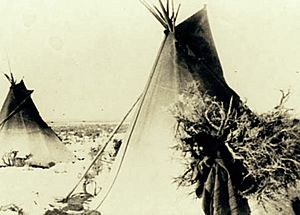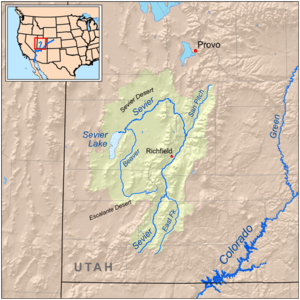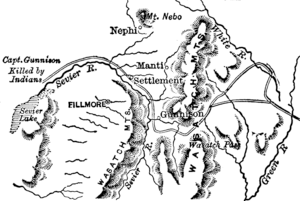Pahvant facts for kids

The Pahvant people were a group of Ute people who lived in what is now Utah. They were known as the "Water People" because they lived near water. They fished, hunted birds, gathered plants, and farmed. In the 1700s, they were friendly. However, after a Pahvant chief's father was killed by new settlers, some Pahvant Utes attacked and killed John Williams Gunnison and seven of his men. Later, the lands where the Pahvant lived became dry because Mormon settlers used the water for farming. The Pahvant people eventually joined with the Paiutes and moved to reservations.
Contents
Where the Pahvant Lived and How They Lived
The Pahvant people lived in Utah, west of the Wasatch Mountains. Their home was near the Sevier River and around Sevier Lake and Fish Lake. This is why they called themselves Pahvant, which means "living near the water" or "water people." Another Ute group, the Moanunts, lived on the other side of the Sevier River. Both groups spoke the same language but were separate. The Pahvant lived much like their neighbors, the Kaibab Paiute, and often married people from the Goshute and Southern Paiute groups.
Their hunting and gathering lands stretched west to the border of Utah and Nevada. In winter, they stayed in six different villages. They hunted birds and fished along the Sevier River. They also hunted deer in the mountains. For food, they gathered roots, berries, and pine nuts. For many years, they also farmed along Corn Creek. By the mid-1800s, they had horses.
Early Encounters: Domínguez–Escalante Expedition
In 1776, explorers named Domínguez and Escalante visited the Pahvant and Moanunts. The Pahvant were called "Bearded Indians" by the explorers. They were described as friendly and helpful people.
Contact with New Settlers
Around 1850, Mormon settlers began moving into the Pahvant's lands. They took the best lands and plowed over native plants. This made it hard for the Pahvant to find food. Sometimes, they had to beg for food or take crops and animals from the settlers.
One leader, J. H. Holeman, said in 1851 that Native Americans were suffering. He said they were "driven from their lands" and "reduced to a state of suffering." He also said that when they asked for payment for their lands, they were sometimes "shot down."
Brigham Young, a leader of the Mormon settlers, disagreed. He told Mormons it was "cheaper to feed Indians than fight them." He set up three farms for local tribes. But these farms became more like feeding stations. The Utes worked the farms, but the harvests were often small. Also, working on the farms kept them from hunting, which they needed to do to survive.
In the fall of 1853, there were several fights between settlers and the Pahvant Utes. The Utes attacked some towns, killed a few settlers, and took cattle. Around October 1853, some settlers passed through Pahvant land. They were talking peacefully until they tried to take bows and arrows from the Utes. A fight started, and the settlers killed the father of Chief Moshoquop. Other Pahvant people were also hurt or killed.
Captain John Williams Gunnison came to the area to map the land for a railroad. He heard about the conflict but thought it was over. He set up camp near Sevier Lake to explore. On October 26, 1853, a group of Pahvant Utes attacked his camp. They killed Gunnison and seven of his men using bows, arrows, and rifles.
After talks with the U.S. military and the Mormons, Chief Kanosh helped arrange for some Pahvant people to face trial in February 1855. One woman and six men were tried. They were found responsible for the deaths of Gunnison and his men. Three of them were sentenced to three years of hard work and a fine. They were taken to a prison near Salt Lake City, but they escaped five days later. Some reports said Mormons helped them escape.
Changes from New Settlements
Mormon settlements made it harder for the Ute people to hunt and gather food. There were fewer fish, wild birds, and native plants. The Mormons also brought diseases that the Utes had never encountered. This caused many Ute people to get sick and die.
Sometimes, grasshoppers and dry weather destroyed the Mormon's crops. This meant they had no extra food to share. The Mormons also used river water for their farms. This caused the water levels in Sevier Lake and the rivers to drop.
The Pahvant and Moanunt people eventually joined the Paiute Indian Tribe of Utah. Some lived at the Kanosh reservation, a small community of houses north of Kanosh, Utah. Others lived near Kanosh but not on the reservation. Some Pahvant people moved to the Uintah and Ouray Indian Reservation. The U.S. government then considered them members of the Uintah tribe.
Notable People
- Kanosh (chief), a respected leader of the Pahvant band.




